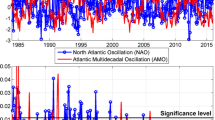Abstract
A time series of geographic images can be viewed from two perspectives: as a set of images, each image representing a slice of time, or as a grid of temporal profiles (one at each pixel location). In the context of Principal Components Analysis (PCA), these different orientations are known as T-mode and S-mode analysis respectively. In the sparse literature on these modes it is recognized that they produce different results, but the reasons have not been fully explored. In this paper we investigate the interactions between space-time orientation and standardization and centering in PCA. Standardization refers to the eigenanalysis of the inter-variable correlation matrix rather than the variance-covariance matrix while centering refers to the subtraction of the mean in the development of either matrix. Using time series of monthly anomalies in lower tropospheric temperature from the Microwave Sounding Unit (MSU) as well as in CO2 in the middle troposphere from the Atmospheric Infrared Sounder (AIRS), we show that with T-mode PCA, standardization has the effect of giving equal weight to each time step while centering has the effect of detrending over time. In contrast, with S-mode PCA, standardization has the effect of giving equal weight to each location in space while centering detrends over space. Further, in the formation of components, S-mode PCA preferences patterns that are prevalent over space while T-mode PCA preferences patterns that are prevalent over time. The two orientations thus provide complementary insights into the nature of variability within the series.




Similar content being viewed by others
References
Ambaum MHP, Hoskins BJ, Stephanson DB (2001) Arctic oscillations or North Atlantic oscillation? J Climate 14:3495–3507
Armstrong MP (1988) Temporality in spatial databases. Proceedings, GIS/LIS’88, 2:880–889
Barnston AG, Livezey RE (1987) Classification, seasonality and persistence of low frequency atmospheric circulation patterns. Mon Weather Rev 115:1083–1126
Berry BJL (1964) Approaches to regional analysis: a synthesis. Ann Assoc Am Geogr 54:2–11
Cattell RB (1952) Factor analysis: an introduction and manual for the psychologist and social scientist. Harper, New York
Chahine MT, Chen L, Dimotakis P, Jiang X, Li Q, Olsen ET, Pagano T, Randerson J, Yung YL (2008) Satellite remote sounding of mid-tropospheric CO2. Geophys Res Lett 35:L17807. doi:10.1029/2008GL035022
Christy JR, Spencer RW, Braswell WD (2000) MSU tropospheric temperatures: dataset construction and radiosonde comparisons. J Atmos Oceanic Technol 17:1153–1170
Compagnucci RH, Richman MB (2008) Can principal component analysis provide atmospheric circulation or teleconnection patterns? Int J Climatol 28:703–726
Compagnucci RH, Salles MA (1997) Surface pressure patterns during the year over southern South America. Int J Climatol 17:635–653
Compagnucci RH, Salles MA, Canziani PO (2001) The spatial and temporal behavior of the lower stratospheric temperature over the southern hemisphere: the MSU view. Part I: data, methodology and temporal behavior. Int J Climatol 21:419–437
Eastman JR, Fulk M (1993) Long sequence time series evaluation using standardized principal components. Photogramm Eng Remote Sens 59:1307–1312
Ehrendorfer M (1987) A regionalization of Austria’s precipitation climate using principal component analysis. J Climatol 7:71–89
Jackson JE (2003) A user’s guide to principal components. Wiley, Hoboken
Johnston RJ (1980) Multivariate statistical analysis in geography. A primer on the general linear model. Longman Scientific and Technical, New York
Jolliffe IT (2004) Principal component analysis. Springer, New York
Klein SA, Soden BJ, Lau NC (1999) Remote sea surface temperature variation during ENSO: evidence for a tropical atmospheric bridge. J Climate 12:917–932
Lau N-C, Nath MJ (1996) The role of the “atmospheric bridge” in linking tropical pacific ENSO events to extratropical SST anomalies. J Climate 9:2036–2057
National Oceanic and Atmospheric Administration (2008) Earth system research Laboratory. Climate Indices: Monthly Atmospheric and Ocean Time Series (ONI). http://www.esrl.noaa.gov/psd/data/climateindices/ Accessed 23 April 2008
National Oceanic and Atmospheric Administration, National Weather Service, Climate Prediction Center (2011) Monthly mean North Atantic Oscillation (NAO) index since January 1950. http://www.cpc.ncep.noaa.gov/products/precip/CWlink/pna/norm.nao.monthly.b5001.current.ascii.table Accessed 9 February 2011
Noy-Meir I (1973) Data transformations in ecological ordination I. Some advantages of non-centering. J Ecol 61:329–341
Noy-Meir I, Walker D, Williams WT (1975) Data transformations in ecological ordination II. On the meaning of data standardization. J Ecol 63:779–800
Richman MB (1986) Rotation of principal components. J Climatol 6:293–335
Salles MA, Canzani PO, Compagnucci RH (2001) The spatial and temporal behavior of the lower stratospheric temperature over the southern hemisphere: the MSU view. PART II: data, methodology and temporal behaviour. Int J Climatol 21:439–454
Sobel AH, Held IM, Bretherton CS (2002) The ENSO signal in tropical tropospheric temperature. J Climate 15:2702–2706
Van den Dool H (2007) Empirical methods in short-term climate prediction. Oxford University Press, Oxford
Walker GT, Bliss EW (1932) World Weather V. Mem Roy Met Soc 4:53–84
Weare BC, Navato AR, Newell RE (1976) Empirical orthogonal analysis of pacific sea surface temperatures. J Phys Oceanogr 6:671–678
Wilks DS (2006) Statistical methods in the atmospheric sciences. International Geophysics series 91. Academic Press (Elsevier), Burlington
Yulaeva E, Wallace JM (1994) The signature of ENSO in global temperature and precipitation fields derived from Microwave Sounding Unit. Am Meteorol Soc 7:1719–1736
Author information
Authors and Affiliations
Corresponding author
Additional information
Communicated by H.A. Babaie
Rights and permissions
About this article
Cite this article
Machado-Machado, E.A., Neeti, N., Eastman, J.R. et al. Implications of space-time orientation for Principal Components Analysis of Earth observation image time series. Earth Sci Inform 4, 117–124 (2011). https://doi.org/10.1007/s12145-011-0082-7
Received:
Accepted:
Published:
Issue Date:
DOI: https://doi.org/10.1007/s12145-011-0082-7




